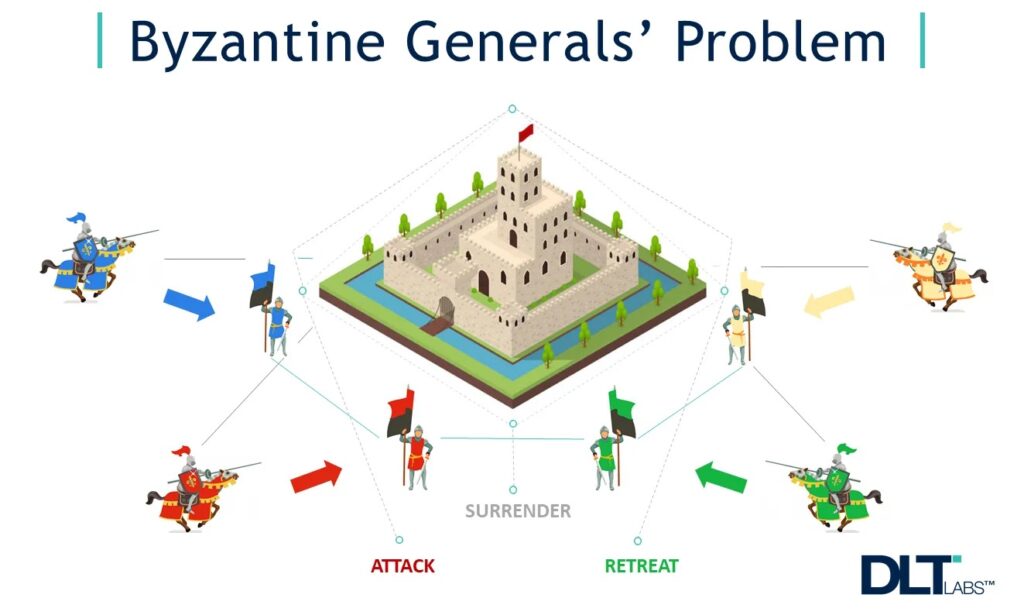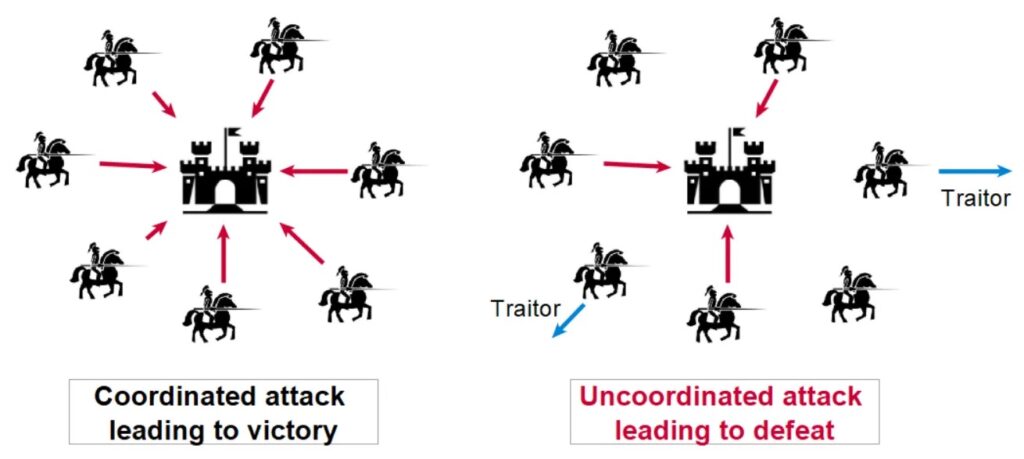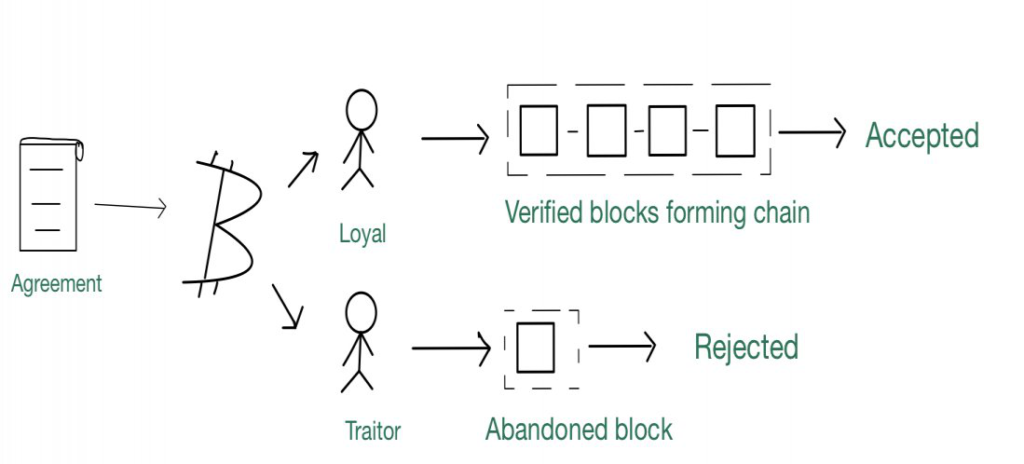What is Byzantine Generals’ Problem in Blockchain?

In recent years, hundreds of blockchain and cryptocurrency projects have been born. More and more development teams understand how blockchain works so they can create a new blockchain. All this is thanks to the first blockchain created by Satoshi Nakamoto, Bitcoin. So, Satoshi’s creation was a significant innovation that provided new solutions to problems facing decentralized systems. One of them is the Byzantine Generals problem which was almost impossible to solve before Bitcoin. So, what is Byzantine Generals’ problem? How does Bitcoin Solve the Byzantine Generals Problem? We will discuss everything below.
Article Summary
- 🏰 The Byzantine Generals’ problem is an analogy that describes the challenge of reaching consensus in a decentralized system. Several generals are trying to attack a Byzantine castle, but they cannot communicate with each other. So, they succeed if they can coordinate to attack and fail if some of them retreat.
- 🏛️ Centralized systems do not face this problem because they have a central authority that makes it easy to reach a consensus.
- 💻 In blockchain, the Byzantine Generals problem is a crucial issue that impacts transaction security, speed, and data integrity.
- 🧠 Bitcoin solves this problem through the Proof of Work consensus mechanism, which ensures the system will always reach consensus as long as 51% of all nodes agree. Bitcoin also uses cryptographic puzzles and encryption systems to ensure security.
- ⚖️ Proof of Stake is an alternative solution to the Byzantine Generals’ problem that utilizes incentive and punishment. PoS offers speed and efficiency but compromises on security.
What is the Byzantine Generals Problem?

The Byzantine Generals’ problem was created by Leslie Lamport, Robert Shostak, and Marshall Pease in 1982. This is a game theory for a problem all decentralized/distributed systems face.
The Byzantine Generals Problem is a problem that describes the difficulty faced by decentralized systems to reach an agreement/consensus without relying on a centralized entity. So, solving the problem is essential for creating a trustless decentralized system.
The problem raises two important questions:
- In a network where no single party is in control, how can parties collectively agree?
- How to achieve consensus among multiple parties when some of them are potentially unreliable or dishonest?
This problem is illustrated by the analogy of several generals attacking Byzantium. If they manage to coordinate and attack at the same time, they win. However, if some generals betray and retreat, they will fail. This problem also assumes that they cannot communicate with each other because there is a risk of the messages being forged by the enemy, taken over, or sent by dishonest generals.
We can think of the Byzantine Generals’ problem as a game of word communication. In this game, players need to pass the same information from the first person to the last person. However, as we know, by the last person the information is often wrong or incorrect. Solving the Byzantine Generals’ problem is similar to figuring out how to ensure this information exchange is accurate, and all players can agree on the information.
To date, the Byzantine Generals problem has not been solved perfectly. Satoshi Nakamoto’s Bitcoin solution is considered the closest to solving this problem. Also, Bitcoin was the first network to solve the problem.
Why is the Byzantine Generals Problem Important for Blockchains?

The Byzantine Generals’ problem is only faced by decentralized systems. Centralized systems such as banks, countries, and hierarchical organizations do not face this problem because they have a single party with full control. Meanwhile, decentralized systems must reach a consensus without third-party interference to create a trustless system.
Centralized systems do not face the Byzantine Generals' problem because they sacrifice transparency to achieve efficiency. However, the fundamental problem of a centralized system is the potential for corruption by the central authority, which implies that data can be manipulated or censored by anyone with control.
In blockchain, the generals are like nodes on a blockchain trying to reach a consensus, which in this context is the finalization of transactions. The Byzantine Generals’ problem must be solved to prevent fraudulent transactions from entering the system, potential attacks from hackers, and ensure the security of data storage. In addition, this problem also needs to be solved to create an accurate record system on the blockchain and prevent the problem of double spending.
You don’t know how blockchain works? Read Pintu Academy’s articles on what is blockchain and how it works.
How does Blockchain Solve the Byzantine Generals Problem?
Bitcoin created by Satoshi Nakamoto is the first time a decentralized currency has successfully solved the Byzantine Generals’ problem. Satoshi does this using the Proof of Work (PoW) consensus method.
In addition, Bitcoin is the first decentralized system to achieve BFT (Byzantine Fault Tolerance). This means that the Bitcoin network will always reach consensus as long as 51% of all nodes/miners behave honestly. So, Bitcoin’s success becomes the basis for many other blockchains.
A system that achieves BFT can reach a consensus even if some parties behave dishonestly. If we go back to the analogy, it means that 51% of all generals coordinated to attack simultaneously and succeeded even though some generals betrayed. BFT is like a rule that creates a minimum threshold for these generals to win.
1. How Bitcoin Solves the Byzantine Generals’ Problem

How Bitcoin handles consensus and “traitor” generals. Source: GeeksforGeeks.
Bitcoin’s Proof of Work (PoW) consensus mechanism was the first to achieve BFT and solve the Byzantine Generals problem. So, Proof of Work systems solves the problem by utilizing complex cryptographic security and encryption systems.
Also read: What is Bitcoin and how the Proof of Work Consensus mechanism works.
All nodes participating in Bitcoin will race to solve a cryptographic puzzle to generate a block hash (the unique identity of each block). So, each time a hash is successfully generated, this information is sent to all nodes/miners and tested for validity.
The genius thing Satoshi implemented in designing Bitcoin was to connect the hash sequences of all the blocks and form a blockchain. The hash or unique code of each block cannot be separated, altered, or moved because it is connected to the first block in the Bitcoin network (Genesis block). This connection ensures that information that has entered the blockchain is permanent and immutable.
So, how does Bitcoin handle the uncertainty of information carried by nodes (or generals in the problem)? What if nodes behave dishonestly?
Bitcoin handles this by applying the 51% rule to achieve BFT. Nodes that carry false information and differ from others will be automatically weeded out of the blockchain on their own. So, as long as 51% of the nodes agree on a piece of information, Bitcoin will always reach consensus.
Satoshi Nakamoto arguably managed to "cheat" the Byzantine Generals problem because he created a P2P (peer-to-peer) encrypted protocol to facilitate communication between all nodes. In Satoshi's system, all generals can securely coordinate with each other to ensure the integrity of information.
Satoshi Nakamoto’s consensus mechanism became the standard for creating trustless decentralized systems. Satoshi’s system proved to have robust security as the Bitcoin blockchain has never been hacked in the last 14 years.
2. Proof of Stake as an Alternative Solution to Achieve BFT

An illustration of the Proof of Stake system. Source: Pintu Academy.
Bitcoin’s PoW consensus mechanism has a very high level of security but sacrifices aspects of scalability and speed (this is called the Blockchain Trilemma). Various blockchain teams are looking for alternative ways to solve the Byzantine Generals’ problem without sacrificing scalability and speed. One of them is the Proof of Stake (PoS) consensus mechanism.
PoS consensus mechanisms rely on capital commitments called stakes. Users who want to participate in securing the network (become validators) need to commit a stake as collateral so that they will carry out their duties and act honestly. If any validator violates the rules, the money they keep as collateral will be slashed by the network.
Do you need to become more familiar with PoS? Check out Pintu Academy’s article on the Proof-of-Stake consensus mechanism!
Furthermore, different from PoW, the PoS system selects a group of generals to be in charge of attacking the Byzantine castle in one period of time. They are chosen semi-randomly based on stake and algorithm. These generals also serve for a short period (called an epoch). This automatically speeds up the process of reaching a consensus.
Thus, The PoS consensus mechanism solves the Byzantine Generals’ problem by specifically selecting the generals on duty and providing economic incentives and potential penalties. With this, the system encourages each general to behave honestly and reach a consensus.
The PoS consensus mechanism is the most widely used blockchain system because it does not require heavy computation, its transaction fees are cheaper, and it is faster. Various PoS networks also have different BFT requirements to ensure the selection of validators can be done safely.
However, PoS systems sacrifice security by assigning responsibility to multiple nodes and this increases the potential for attacks, hacking, and dishonest validators. To address this weakness, many PoS systems increase the BFT requirement to 2/3 of the total validators to reach consensus (instead of 51% like Bitcoin). If we go back to the analogy of Byzantine generals, if there are 6 generals in charge of attacking, there must be 4 generals coordinating simultaneously to attack.
Conclusion
The Byzantine Generals problem is a theoretical challenge for describing the difficulty of achieving consensus in decentralized systems. This problem was first solved by Bitcoin through its Proof-of-Work (PoW) consensus mechanism, which sets the standard for consensus in decentralized systems. Centralized systems, such as banks and countries, do not face this problem because there is a central authority in control. So, this issue must be addressed to ensure the security of transactions and data. In addition to PoW, Proof of Stake (PoS) consensus mechanisms also offer alternative solutions with their advantages and disadvantages, including in terms of security and scalability.
How to Buy Cryptocurrencies on the Pintu App
References
- “What Is the Byzantine Generals Problem?”, River, accessed on 7 September 2023.
- Archita2k1, “Byzantine Generals Problem in Blockchain”, Geeksforgeeks, accessed on 7 September 2023.
- Cos, “Bitcoin’s Proof of Work: The Problem of the Byzantine Generals”, The Startup Medium, accessed on 7 September 2023.
- “How does blockchain solve the Byzantine generals’ problem?”, Coin Telegraph, accessed on 8 September 2023.
- George Georgiev, “Byzantine Fault Tolerance in Blockchain: A Closer Look”, Crypto Potato, accessed on 8 September 2023.
- Giovanni Zaarour, “The Fault-Tolerant Consensus Problem and Its Solutions in Blockchains and Distributed Systems”, Medium, accessed on 8 September 2023.
Share


